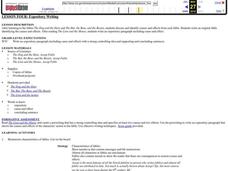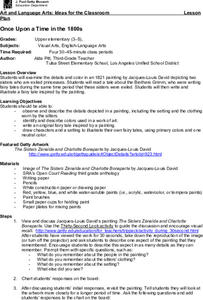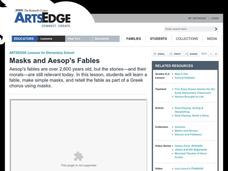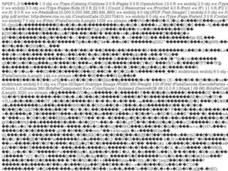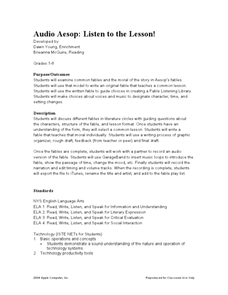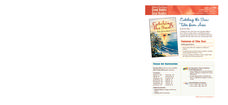Curated OER
Writing Fables
Students develop a working skill of using graphic organizers for writing. The instructional activity notes that the best kind of organizer is one that is engaging to the appropriate audience. The assessment follows the rubric given in...
Curated OER
Expository Writing
Write an expository paragraph First, writers first read three fables and identify a cause and effect relationship in the fables. Then, they write their own expository paragraph with a cause and effect relationship. A list of...
Curated OER
Fearless Fables
This literature-based worksheet presents pupils with the fable "The Lion and the Elephant Retold" by Ellen Baumwoll. No lesson is attached but the handout could be used as a resource to create Reader's Theater.
Curated OER
Once upon a Time in the 1800's
Young readers examine the details in an 1821 painting by Jacques-Louis David depicting two sisters who are exiled princesses. They read a tale about the Brothers Grimm, who were writing fairy tales during the same time period that these...
Curated OER
Elements of Fables
Students explore the attributes of fables. In this literature lesson, students read several fables and identify the moral lesson, characterization, and figurative language in each. Students then retell their favorite fables in their own...
Curated OER
Understanding and Writing Fables
Third graders review with the teacher the characteristics for a fable and what it is. They read one paragraph each from the story, "The Fox and the Stork" aloud. They then answer comprehension questions aloud. Next, they listen to four...
Curated OER
What Makes a Fable?
Third graders explore fables. For this fables lesson, 3rd graders use Venn Diagrams to organize information about 2 fables they will read. Students work in groups to fill out the diagrams and share their results with the class. Students...
Curated OER
Masks and Aesop's Fables
Students study and perform Aesop's fables. In this Aesop's fables lesson, students read and/or listen to a number of the famous fables. They make masks based on the characters and perform a fable using the masks. They write about the...
Curated OER
Comprehension Skills: Evaluate Using Fiction Stories and Aesop's Fables
Primary readers investigate several comprehension skills in the ten lessons of this unit. Forming opinions about stories, comparing stories to each other, using Venn Diagrams, and applying the ideas from a story to real life situations...
Scholastic
Folk and Fairy Tale Readers: The Tortoise and the Hare
Slow and steady wins the race to fluent reading with this printable version of "The Tortoise and the Hare". Presenting children with fun illustrations and a repetitive story structure, this resource is perfect for developing...
Curated OER
Determining Author's Point of View: The Sneeches
Determine the author's point of view in a text. Young readers read Dr. Seuss' The Sneeches and identify the author's purpose in the story. They identify persuasive techniques in writing, asking and answering questions to better...
Curated OER
Aesop's Fables (Grade 3)
Third graders develop a presentation based on Aesop's Fables. For this Aesop Fables and presentation lesson, 3rd graders examine the characteristics of fables and how to interpret them. They choose one of Aesop's Fables to research. They...
Learning Station
Writing Playscripts
In this writing learning exercise, students read a short description of a play script. Then, students read a fable and write a play script of the fable.
Curated OER
Theme and Fables Review
In this fables worksheet, students read fables and write the moral of the story and how their answer relates to the story. Students do this for 5 stories.
Curated OER
Writing A Fable - Pets
Students recognize the elements of a fable. In this writing a fable lesson, students discuss fables and write their own using the elements discussed.
Curated OER
Fable Writing
Students listen to and discuss various fables, and identify the moral and central themes. They write their own personal fables and create illustrations to go with them.
Curated OER
Audio Aesop: Listen to the Lesson!
Aesop's Fables are the focus of this language arts instructional activity. Young philosophers study and discuss the morals found in the most famous of Aesop's Fables. They write an original fable that teaches a common moral. A "Fable...
Curated OER
How to Make Plurals of Words That End In "f" or "fe": A "F"able
Identify nouns that end in "f" or "fe." Review how to make words plural and the specific rules for words that end in "f" or "fe." Complete the fable activity sheet and find and write the plurals for words they find that end in "f" or...
Pearson
Catching the Sun: Tales from Asia
Explore the folklore of Asia and the South Pacific with this language arts lesson series. Complementing a reading of Catching the Sun: Tales from Asia by Jan M. Mike, this resource supports learners with understanding cause and...
Curated OER
I Hate to Complain but your Cheese Stinks
Learners read and discuss the "fractured" fairy tale "The Stinky Cheese Man". They imagine that they are in the fairy tale and write a letter of complaint concerning the Cheese Man and how he stinks up the town.
Core Knowledge Foundation
First Grade Skills Unit 3
Four weeks, 19 lessons—this unit covers five new vowel spelling patterns, tricky words, spellings, verb tenses, reading fables and exploring the writing process. Lessons offer review, an introduction to the concept, skills practice,...
Curated OER
Acting Like a Bunch of Animals: Fables and Human
The video "The Tales of Aesop" traces for viewers the history of fables and identifies their characteristics. The class then goes to the web site "The Fisherman and the Little Fish" where they examine the classic and a modern version of...
Curated OER
June 4, 620 BC - Aesop's Fables
In this writing prompt worksheet, students learn that June 4, 620 BC was the birthday of Greek born Aesop of Aesop's fables. Students use resources in the classroom to research the fables and then write a fable of their own.
Curated OER
Fables and Trickster Tales Around the World
Students analyze fables and trickster tales from various cultural traditions. In this fable analysis lesson plan, students identify the elements of fables and trickster stories. Students read Aesop's fables and Ananse spider...
Other popular searches
- Writing Fables and Folktales
- Writing Fables Middle School
- Writing Fables 4th Grade
- Writing Fables Grade 6
- Writing Fables Mind Map
- Writing Fables Gr 5
- Writing Fables Rubric
- Writing Fables Gr 2
- Writing Fables Animal Farm
- Writing Fables Gr 3
- Aesop's Fables and Writing
- Fables Six Traits Writing



